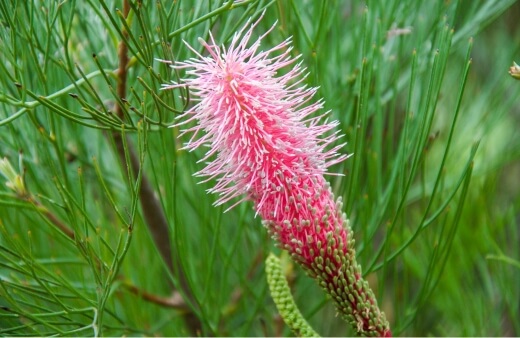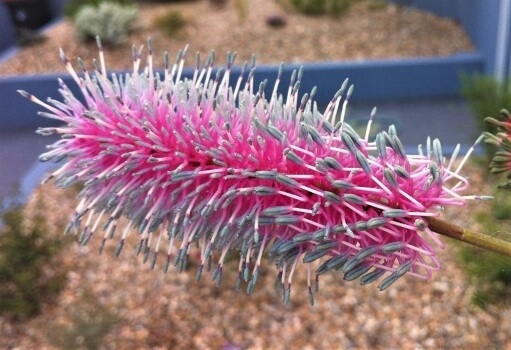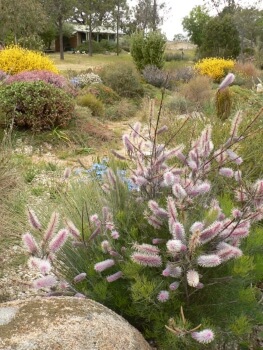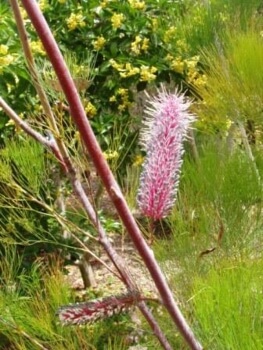Grevillea magnifica is truly just that, magnificent. It is a unique species in the genus that features iridescent pink to purple cylindrical flower spikes that start in winter and then open to a lovely pink and white during spring.
Its relaxed, open growth habit offers many practical and ornamental applications within residential gardens while the plant itself is an excellent low-maintenance addition for growers.
While this shrub may not be as widely cultivated as some of its relatives, it is certainly gaining popularity thanks to its highly decorative blooms. Here is your guide to growing and caring for this special Grevillea species.
More...

Family: | Proteaceae |
|---|---|
Genus: | Grevillea |
Species: | G. magnifica |
Origin: | Australian Native |
Common Names: | Grevillea pink pokers (unofficial) |
Location: | Outdoor |
Type: | Shrub |
Growth: | Up to 4 metres tall and 2 metres wide |
Sun requirements: | Full sun to light shade |
Foliage Colour: | Green |
Flower Colour: | Pink |
Flowering: | Late winter to spring |
Maintenance level: | Low |
Poisonous for pets: | Non-toxic to cats and dogs |
Presenting Grevillea magnifica

Source: Karlo Taliana from Sydney, Australia
Looking at its elegant form, this shrub comprises prolific clusters of pink flowers that sit atop wiry, gently arching stems that rise from the dense green foliage beneath. The flower spikes will sway gracefully with the wind, offering some charming movement to outdoor landscapes.
Scientifically labelled Grevillea magnifica, this plant's unofficial common name is ‘Grevillea Pink Pokers’ which is an obvious nod to the pink flower spikes. It was previously recognised as a subspecies of Grevillea petrophiloides and is closely related to Grevillea oligomera.
Part of the Proteaceae family, this species is native to Western Australia and thrives in temperate to Mediterranean climate zones. In good conditions, this shrub will flower from winter to spring with spot flowering occurring all year.
Grevillea Pink Pokers' Growth Habits and Uses
Grown in gardens, this shrub will typically reach up to 4 metres tall and 2 metres wide with a medium growth rate. It can be kept smaller if grown in containers. The blooms will attract nectar-feeding birds and bees.
Grevillea pink pokers can be used for general garden shrubbery or gap filling. It will also make for an excellent feature plant if allowed to grow and spread. Alternatively, it will perform well if grown in patio container gardens.
How to Grow Grevillea magnifica

Source: Australian Native Plants Society
Establishing a healthy nursery plant is always recommended as it is a quick and reliable way to start growing your own plant. This species should be available at select local or online retailers.
Alternatively, you can propagate Grevillea magnifica using firm cuttings from the current season’s growth which should strike reliably. Be sure to refer to our in-depth guide on how to take cuttings If you need some guidance with propagating using cutting.
Planting and Growing Conditions for Grevillea magnifica
These shrubs will perform best in an open position in the garden with good air circulation. Planting should be done in spring or autumn once temperatures are less hostile.
Soil Needs
Very well-draining soil is essential for this species to thrive. It will tolerate different soil types as long as good drainage is present. For poorer soils, you can add some well-rotted manure or compost for a boost. Use quality potting soil for container-grown shrubs.


Get Your Free Guide:
Master Growing Australian Natives eBook
A Must Have Complete Guide for Every Australian Garden
Get Your Free Guide:
Master Growing Australian Natives eBook
A Must Have Complete Guide for Every Australian Garden
Light Requirements
A position that gets full sun is preferred but light shade can be tolerated. Full sun will ensure more vigorous growth and flowers whereas shade could impede growth and lead to fewer flowers blooming.
Temperature and Humidity
This species is tolerant to temperature as long as it generally stays above 7°C. On the other hand, it will not tolerate overly humid conditions. A low to medium humidity level of around 50% or lower is recommended.
Caring for Grevillea magnifica
This plant is only tolerant to light frost but will be drought tolerant once established.
Watering Needs
Water your shrub about once a week for roughly 10 minutes. During long dry spells, water deeply to keep the plant looking good. You can reduce watering in winter.
Pruning
Tip prune during the active months to maintain a bushy growth habit then prune after flowering to remove spent flowers.
Fertilising Grevillea magnifica
While not needed, you can feed with a native plant fertiliser low in phosphorus during spring to boost overall plant vigour during flowering.
Mulching
Add a healthy layer of organic mulch or pine bark mulch around the shrub in summer to maintain a cool environment for the roots.
Grevillea magnifica Pests, Problems and Diseases
This species rarely suffers from any pest or disease issues in good conditions. Leaf spots can occur if you over-fertilise with phosphorus and root rot can become a problem if you overwater your plant.
Grevillea magnifica Frequently Asked Questions

Source: Australian Native Plants
What is the best soil for Grevillea magnifica?
Well-drained soils are essential. Avoid soils with a pH of more than 7 as grevilleas prefer slightly acidic soils. For less well-drained soils, create a raised bed to improve drainage.
What is the best fertiliser for Grevillea magnifica?
It is best to use organic fertilisers that are safe for native plants. It is also very important to use fertilisers low in phosphorus.
Is Grevillea magnifica common in Australia?
This Western Australian species is not a very commonly cultivated plant in residential spaces yet. However, it is slowly gaining popularity thanks to its unique pink flowers.
Check out our main Grevillea guide If you’re looking for other colourful varieties with brilliant blooms.
Add a Touch of Magnificence to Your Garden with Grevillea magnifica
Sporting iridescent pink flower spikes atop bowing branches and a relaxed open form, it's no wonder Grevillea magnifica is gaining such popularity in gardens across the country.
The long-lasting blooms can add lovely pops of colour and a cheerful presence to your outdoor spaces while the plant requires only basic care and little maintenance.
Start growing your very own Grevillea magnifica to take advantage of this native shrub's wonderful landscaping applications.
Published on April 12, 2023 by Nathan Schwartz
Last Updated on February 23, 2024




